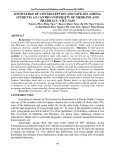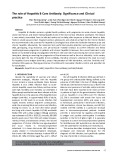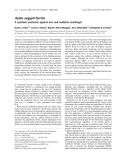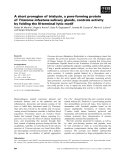
Transmitted diseases
-
Dengue hemorrhagic fever (DHF) is one of the most important diseases mosquitoes transmit due to its rapid spread and economic burden. This study aimed to assess the changes in serum aminotransferase levels (aspartate aminotransferase - AST and alanine aminotransferase - ALT) in DHF patients with or without warning signs and related factors.
 10p
10p  vimitsuki
vimitsuki
 30-03-2025
30-03-2025
 0
0
 0
0
 Download
Download
-
Viet Nam was one of the countries with the highest abortion rate in the world, of which about 70% were of the adolescents. Nowadays, students at Can Tho University of Medicine and Pharmacy are facing many problems related to reproductive health such as unwanted pregnancy, abortion, sexually transmitted diseases, homosexuality.
 8p
8p  viakimichi
viakimichi
 17-01-2025
17-01-2025
 2
2
 2
2
 Download
Download
-
Genital warts are a disease with the highest proportion of sexually transmitted diseases, which are caused by Human Papillomaviruses. Currently, research on the impact on the quality of life of patients with genital warts in Vietnam is still very limited, while this is an issue that deserves attention and has been studied in many places around the world.
 7p
7p  vinara
vinara
 11-01-2025
11-01-2025
 2
2
 1
1
 Download
Download
-
Hepatitis B infection remains a global health problem, with progression to acute-chronic hepatitis, severe liver failure, and death making hepatitis B one of the most serious infections worldwide. The disease is most widely transmitted from an infected mother to her baby, after exposure to infected blood or body fluids or unsafe sexual contact.
 6p
6p  viharuno
viharuno
 03-01-2025
03-01-2025
 2
2
 2
2
 Download
Download
-
STDs là viết tắt của cụm từ (Sexually Transmitted Disease) – bệnh lây truyền qua đường tình dục. Đây là những căn bệnh lây từ người này sang người người khác qua các hình thức quan hệ tình dục (qua âm đạo, đường miệng hay hậu môn). Không phải bệnh STDs nào cũng có thể chữa khỏi.
 85p
85p  motorola_12
motorola_12
 01-06-2013
01-06-2013
 46
46
 5
5
 Download
Download
-
Báo cáo khoa học: Aedes aegypti ferritin A cytotoxic protector against iron and oxidative challenge?
Diseases transmitted by hematophagous (blood-feeding) insects are responsible for millions of human deaths world-wide. Inhematophagous insects, thebloodmeal is important for regulating egg maturation. Although a high concentra-tion of iron is toxic for most organisms, hematophagous insects seemunaffectedby the iron load inabloodmeal.One means by which hematophagous insects handle this iron load is, perhaps, by the expression of iron-binding proteins, specifically the iron storage protein ferritin....
 8p
8p  tumor12
tumor12
 20-04-2013
20-04-2013
 47
47
 4
4
 Download
Download
-
Triatoma infestans(Hemiptera: Reduviidae) is a hematophagous insect that transmits the protozoan parasite Trypanosoma cruzi, the etiological agent of Chagas’ disease. Its saliva contains trialysin, a protein that forms pores in membranes. Peptides based on the N-terminus of trialysin lyse cells and fold into a-helical amphipathic segments resembling antimicrobial peptides. Using a specific antiserum against trialysin, we show here that trialysin is synthesized as a precursor that is less active than the protein released after saliva secretion. ...
 9p
9p  media19
media19
 06-03-2013
06-03-2013
 51
51
 2
2
 Download
Download
CHỦ ĐỀ BẠN MUỐN TÌM



















